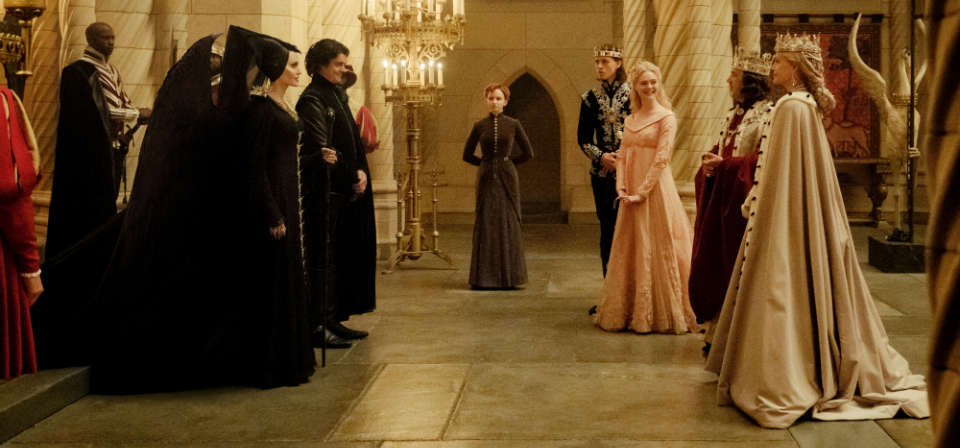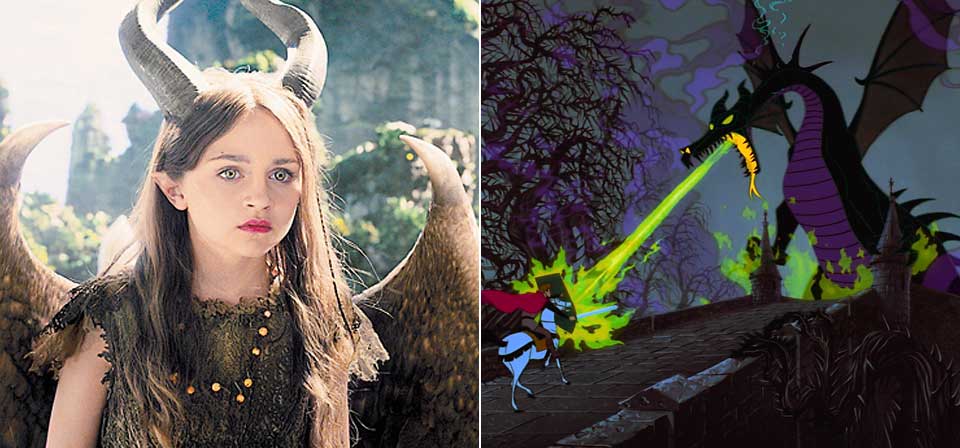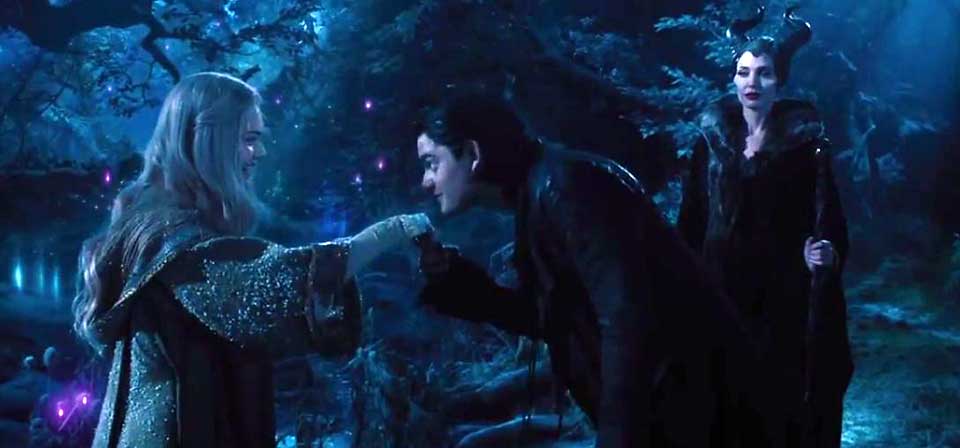Maleficent, Rape and Sympathy for the Devil
In my latest Mailbag, a reader writes:
The fact that you see the removal of Maleficent’s wings as a representation of rape or genital mutilation, in my opinion, exposes to me your “master of suspicion” attitude toward the film. The removal of her wings need not be so much a representation of spiritual rape as a death of innocence of a young girl by a man suffering from selfish concupiscence. Isn’t this indeed the state of reality we live in today in our society?
Maleficent’s innocence was stolen and she hardens her heart. The visualization of this when she sits upon her throne (which appears to be a rib cage; she is hiding inside her heart, queen of her own heart) and builds up the wall of thorns to prevent any other from entering. Can’t we all relate to this? Haven’t we all been wounded so deeply that we close our hearts?
The scene where her heart begins to soften while observing the innocence of Aurora. She is overcome with memories and puts Aurora into a sleep because she is not ready to open her heart again. It’s too painful to remember her lost innocence.
I truly am extremely disappointed in your review and the fact that you have shed such a negative light on to a movie that I see has such theological relevance.
I’m always glad to hear that someone has appreciated or benefited from a movie I criticized. I have no need to persuade everyone to see movies the same way I do, and no wish to deprive anyone of any enjoyment, enlightenment or edification they have received while watching a movie, no matter what I thought of the movie.
For what it’s worth, shortly after I received your email, Angelina Jolie gave an interview in which she confirmed that both she and screenwriter Linda Woolverton were “very conscious” of the force of Stefan maiming Maleficent by hacking off her wings as “a metaphor for rape.” So far from being suspicious, I wasn’t even criticizing or judging the film on that ground. It was an observation, not an accusation. I did say it was “a pretty dark subtext for a PG movie,” but that was by way of parental advisory, not criticism.
However, we can’t — or at any rate I can’t — watch a movie like Maleficent without comparing and contrasting it with its source material, the story of Sleeping Beauty, particularly in Disney’s 1959 animated film. (This is something I could have brought out more clearly in my review. For what it’s worth, my review was written within 12 hours of seeing the film, which is not ideal. I like to have at least a day to chew over a film before reviewing it.)
A story like this demands to be seen through the lens of what biblical scholars call “redaction criticism,” which basically means “What was changed, added or deleted in this retelling of the story, and what do those changes tell us about the storyteller’s intentions and outlook?”
Seen through that lens, what stands out to me is this.
- An entirely good character in the animated film, King Stefan, has been turned into an entirely unsympathetic, cruel, ambitious monster of a man. His motives are important: He horrifically victimizes Maleficent, not out of malice, but out of ambition for power in a patriarchal system. (Note that the old king has daughters but no sons, so his heir will be, not one of his daughters, but the random man to whom he gives his daughter’s hand in marriage. In this patriarchal world the princesses matter only as a prize to be won and a stepping-stone to the throne.)
- Maleficent herself — one of the most iconically evil, even satanic characters in all of Disney history, the self-professed “mistress of all evil” in league with “all the powers of hell” (with a raven called Diablo), who turns into a dragon and does battle with a Christian knight bearing the cross on the “shield of virtue” and wielding the “sword of truth” — has been turned into a basically sympathetic victim and heroine.
- Prince Philip, perhaps the most iconically heroic male character in any Disney animated film ever, bearing allegorical arms evocative of Ephesians 6, has been reduced to a useless walk-on and a comic prop with absolutely nothing to contribute or accomplish. No dragon-fighting, no Christian warrior armor and certainly no true love’s kiss.
- The three good fairies who support King Stefan against Maleficent — silly and incompetent in the original, but still capable of effective action at times, from countering Maleficent’s curse to freeing Prince Philip from captivity and equipping him with his magical armor — are now completely incompetent and useless. Not only does the third good fairy’s interrupted gift no longer matter, Maleficent herself must actually protect and care for Aurora from infancy, or she would have died many times over.
The cumulative effect of all these changes is to invert the moral world of the original story: The satanic villain is actually the victim heroine; the traditional, patriarchal cultural system that condemns her is actually evil. If this isn’t quite sympathy for the devil, it’s only one step away from Gnostic-inflected narratives, such as Philip Pullman’s His Dark Materials, in which Satan is characterized as a heroic rebel against a tyrant creator-god figure (the ultimate patriarch).
Even though Maleficent is a heroine, she is still presented as a satanic figure. Her iconic horns (which Disney artist Marc Davis, who designed Maleficent, says were inspired by the traditional look of the devil, to “frighten everybody half to death”) are present even before Stefan’s betrayal. Her raven, called Diablo in his animated form, is here called “Diaval” — a name that looks like a portmanteau of “Diablo” and its English cognate “Devil.”
Added to this, I can’t help seeing this film partly in light of Maleficent screenwriter Linda Woolverton’s last revisionist fairy tale, Alice in Wonderland: an exercise in what I’ve called “Squelched Girl Syndrome,” i.e., an aggrieved feminist narrative of how patriarchal society systematically robs young girls of their specialness.
Maleficent seems to me to express a similar point of view. If, say, Prince Philip, Stefan’s wife or the good fairies had been stronger characters, or if the film had held out redemption to Stefan, I might have seen it differently.
None of this invalidates the elements you saw in the film or the experience you had of it. I am suggesting, though, that your positive experience of the film in some measure owes more to your own worldview and perspective than to that of the filmmakers or to the film itself.
If you disagree with some or all of this, that’s okay. No one has to agree with me. I’m not the pope of movies. There is no pope of movies. Even the pope isn’t the pope of movies.
I hope that helps.
Related

Maleficent: Mistress of Evil (2019)
It’s tempting to suppose that Maleficent: Mistress of Evil opening in the wake of Columbus Day isn’t a coincidence.

How Disney’s Maleficent subverts the Christian symbolism of Sleeping Beauty
Give me princesses like Leia from Star Wars, Merida from Brave or Tiana from The Princess and the Frog any day. But there’s a difference between creative revisionism and simple inversion.
![Maleficent [video]](/uploads/articles/maleficent.jpg)
Maleficent [video] (2014)
Angelina Jolie is perfect for the part of Disney’s most iconically evil villainess. If only they’d let her play it for more than one scene.

Maleficent (2014)
It’s fair to say that Disney’s Maleficent plays to an extent as warmed-over Frozen. This is not a good thing, even, I think, if you are a fan of Frozen.
Recent
- Benoit Blanc goes to church: Mysteries and faith in Wake Up Dead Man
- Are there too many Jesus movies?
- Antidote to the digital revolution: Carlo Acutis: Roadmap to Reality
- “Not I, But God”: Interview with Carlo Acutis: Roadmap to Reality director Tim Moriarty
- Gunn’s Superman is silly and sincere, and that’s good. It could be smarter.
Home Video
Copyright © 2000– Steven D. Greydanus. All rights reserved.